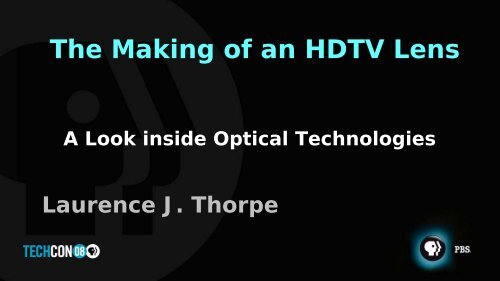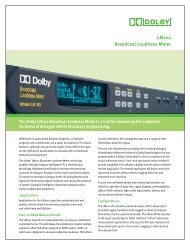The Making of an HDTV Lens - PBS
The Making of an HDTV Lens - PBS
The Making of an HDTV Lens - PBS
You also want an ePaper? Increase the reach of your titles
YUMPU automatically turns print PDFs into web optimized ePapers that Google loves.
<strong>The</strong> <strong>Making</strong> <strong>of</strong> <strong>an</strong> <strong>HDTV</strong> <strong>Lens</strong><br />
A Look inside Optical Technologies<br />
Laurence J. Thorpe
<strong>The</strong> <strong>Making</strong> <strong>of</strong> <strong>an</strong> <strong>HDTV</strong> <strong>Lens</strong><br />
• What makes a “High Definition” <strong>Lens</strong> ?<br />
• <strong>The</strong> distinct separation between the large “Box” <strong>Lens</strong><br />
<strong>an</strong>d the Portable EFP/ENG lens<br />
• Portable HD <strong>Lens</strong>es – New Cost-Perform<strong>an</strong>ce dilemma<br />
• <strong>The</strong> “Sweet zone” <strong>of</strong> operation <strong>of</strong> <strong>an</strong> <strong>HDTV</strong> <strong>Lens</strong><br />
• A glimpse into the world <strong>of</strong> <strong>HDTV</strong> <strong>Lens</strong> design
<strong>The</strong> <strong>Making</strong> <strong>of</strong> <strong>an</strong> <strong>HDTV</strong> <strong>Lens</strong><br />
What makes<br />
a<br />
“High Definition” <strong>Lens</strong>?
Optical “High Definition”<br />
Concept <strong>of</strong><br />
Line Pairs<br />
Per<br />
Millimeter
2/3-Inch Image Format<br />
9.6mm<br />
5.4mm 11 mm<br />
1mm
2/3-Inch Image Format<br />
9.6mm<br />
5.4mm 1mm<br />
?
HD Camera Resolution<br />
• <strong>Lens</strong>-camera resolution in the vertical domain is<br />
determined by the number <strong>of</strong> vertical samples<br />
• <strong>The</strong>re are 1080 vertical samples in the 1080-line<br />
HD format
HD <strong>Lens</strong>-Camera Resolution<br />
• <strong>Lens</strong>-camera resolution in the vertical domain is<br />
determined by the number <strong>of</strong> vertical samples<br />
• <strong>The</strong>re are 1080 vertical samples in the 1080-line<br />
HD format<br />
• <strong>Lens</strong> Camera resolution in the horizontal domain is<br />
determined by the camera b<strong>an</strong>dwidth<br />
• SMPTE recommended filter limits this to 30 MHz
• 2/3-Inch Format<br />
Resolution <strong>of</strong> <strong>an</strong> <strong>HDTV</strong> <strong>Lens</strong><br />
Coupled to a 1920 (H) x 1080 (V) Imager<br />
9.6mm<br />
2/3-Inch<br />
5.4mm Image Format<br />
1080 Lines<br />
= 540 Lp/mm<br />
• 1080-line sc<strong>an</strong>ning c<strong>an</strong> unambiguously resolve 540 black <strong>an</strong>d white<br />
cycles (or Line Pairs)<br />
• 540 LP within a vertical image height <strong>of</strong> 5.4 mm me<strong>an</strong>s the HD lens<br />
must be capable <strong>of</strong> tr<strong>an</strong>sferring 540 / 5.4 = 100 Line Pairs per<br />
millimeter (LP/mm) with as high contrast as possible
One<br />
Millimeter<br />
1080-Line <strong>HDTV</strong><br />
For the 1920 (H) x 1080 (V)<br />
<strong>HDTV</strong> St<strong>an</strong>dard<br />
<strong>The</strong> <strong>Lens</strong><br />
must be capable<br />
<strong>of</strong> tr<strong>an</strong>sferring<br />
100 Line Pairs<br />
per<br />
Millimeter<br />
with High Contrast
One<br />
Millimeter<br />
480-Line SDTV<br />
For the 720 (H) x 480 (V)<br />
SDTV St<strong>an</strong>dard<br />
<strong>The</strong> <strong>Lens</strong><br />
must be capable<br />
<strong>of</strong> tr<strong>an</strong>sferring<br />
44 Line Pairs<br />
per<br />
Millimeter<br />
with High Contrast
<strong>The</strong> <strong>Making</strong> <strong>of</strong> <strong>an</strong> <strong>HDTV</strong> <strong>Lens</strong><br />
So far, we have only spoken about<br />
<strong>HDTV</strong> resolution (at the center <strong>of</strong> the lens)<br />
<strong>The</strong>re are m<strong>an</strong>y other key optical parameters<br />
that also contribute to<br />
overall image quality
Overall <strong>HDTV</strong> <strong>Lens</strong> Perform<strong>an</strong>ce<br />
1. Sensitivity<br />
2. Image Sharpness<br />
(at picture center)<br />
3. Image Sharpness<br />
(at picture corners)<br />
4. Relative Light Distribution<br />
(evenness <strong>of</strong> brightness<br />
across image pl<strong>an</strong>e)<br />
5. Black Reproduction<br />
6. Contrast Ratio<br />
7. Chromatic Aberration<br />
8. Monochromatic Aberrations<br />
9. Geometric Distortion<br />
10. Focus Breathing<br />
(Ch<strong>an</strong>ge in <strong>an</strong>gle <strong>of</strong> view<br />
as focus is adjusted)
Hierarchy <strong>of</strong> Program Genres<br />
• Small Market News<br />
• Ancillary News<br />
• B & I Production<br />
• Wedding & Event<br />
• Corporate<br />
• Education<br />
• ProSumer<br />
• News<br />
• Reality Shows<br />
• Freel<strong>an</strong>ce Journalist<br />
• Major budget Movie<br />
• Mid budget Movie<br />
• TV Commercials<br />
• Prime Time Drama<br />
• Sitcom<br />
• Comedy show<br />
• Sports & Events<br />
• Natural History<br />
• Documentary<br />
• Magazine<br />
Very<br />
High-End<br />
High-End<br />
Mainstream<br />
HD Workhorse<br />
Low-budget<br />
HD Production
Hierarchy <strong>of</strong> <strong>HDTV</strong> Production Budgets<br />
• Production Budgets<br />
$ 100M<br />
• Production Budgets<br />
$ 250K<br />
$ 10K<br />
Very<br />
High-End<br />
Hi-End<br />
Mainstream<br />
HD Workhorse<br />
Low-budget<br />
HD Production<br />
• Production Budgets<br />
$250M<br />
$ 50M<br />
$ 1M • Production Budgets<br />
$ 2 M<br />
$100K
Hierarchy <strong>of</strong> Digital <strong>HDTV</strong> Acquisition system<br />
$ 80,000<br />
$ 30,000<br />
$ 15,000<br />
2/3-inch<br />
HD Camcorders<br />
1/3-inch<br />
HD Camcorders<br />
1/4 <strong>an</strong>d 1/5-inch<br />
Camcorders<br />
2/3-inch<br />
HD Cameras<br />
HD Camcorders<br />
2/3-inch<br />
HD Cameras<br />
HD Camcorders<br />
> $250K<br />
35mm<br />
Very<br />
High-End<br />
High End<br />
Mainstream<br />
HD Workhorse<br />
Low-budget<br />
HD Production<br />
Single Sensor Cameras<br />
2/3-inch<br />
HD Cameras<br />
HD Camcorders<br />
1/2-inch<br />
HD Cameras<br />
HD Camcorders
Hierarchy <strong>of</strong> Tri-Imager Digital Cameras/Camcorders<br />
$ 30,000<br />
• 2/3-inch<br />
• 1/2-inch<br />
• 1/3-inch<br />
Exclusively<br />
2/3-inch<br />
Very<br />
High-End<br />
High-End<br />
Mainstream<br />
HD Workhorse<br />
Low-Budget<br />
HD Production<br />
Box <strong>Lens</strong>es<br />
• Field<br />
• Studio<br />
Portable <strong>Lens</strong>es<br />
• Cine<br />
• EFP<br />
Portable <strong>Lens</strong>es<br />
• EFP<br />
• ENG<br />
• Low-cost studio
<strong>The</strong> <strong>Making</strong> <strong>of</strong> <strong>an</strong> <strong>HDTV</strong> <strong>Lens</strong><br />
<strong>The</strong> Distinct Separation<br />
between the<br />
Large “Box” <strong>Lens</strong><br />
<strong>an</strong>d the<br />
Portable EFP/ENG lens
Difference between<br />
Full Size Studio <strong>an</strong>d Portable ENG <strong>Lens</strong><br />
Full Size Studio<br />
• Primary consideration is highest overall<br />
Imaging Perform<strong>an</strong>ce
Full Size Studio<br />
• Primary consideration is highest overall<br />
Imaging Perform<strong>an</strong>ce<br />
Difference between<br />
Full Size Studio <strong>an</strong>d Portable ENG <strong>Lens</strong><br />
• Large glass elements used:<br />
• To elevate optical sensitivity<br />
• Facilitate tighter control <strong>of</strong> surface toler<strong>an</strong>ces for<br />
highest perform<strong>an</strong>ce<br />
• More glass elements deployed:<br />
• To provide more design degrees <strong>of</strong> freedom to<br />
achieve lower monochromatic <strong>an</strong>d chromatic<br />
aberrations<br />
• Weight rapidly increases<br />
• Not a signific<strong>an</strong>t consideration with full studio<br />
cameras<br />
• Typical studio lenses weigh in between 45<br />
<strong>an</strong>d 50 lbs
Full Size Studio<br />
• Primary consideration is highest overall<br />
Imaging Perform<strong>an</strong>ce<br />
Difference between<br />
Full Size Studio <strong>an</strong>d Portable ENG <strong>Lens</strong><br />
• Large glass elements used:<br />
• To elevate optical sensitivity<br />
• Facilitate tighter control <strong>of</strong> surface toler<strong>an</strong>ces for<br />
highest perform<strong>an</strong>ce<br />
• More glass elements deployed:<br />
• To provide more design degrees <strong>of</strong> freedom to<br />
achieve lower monochromatic <strong>an</strong>d chromatic<br />
aberrations<br />
• Weight rapidly increases<br />
• Not a signific<strong>an</strong>t consideration with full studio<br />
cameras<br />
• Typical studio lenses weigh in between 45<br />
<strong>an</strong>d 50 lbs<br />
ENG Portable<br />
• Primary consideration is lowest<br />
Size <strong>an</strong>d Weight
Portable HD ENG/EFP <strong>Lens</strong>es
Difference between<br />
Full Size Studio <strong>an</strong>d Portable ENG <strong>Lens</strong><br />
Full Size Studio<br />
• Primary consideration is highest overall<br />
Imaging Perform<strong>an</strong>ce<br />
• Large glass elements used:<br />
• To elevate optical sensitivity<br />
• Facilitate tighter control <strong>of</strong> surface toler<strong>an</strong>ces<br />
for highest perform<strong>an</strong>ce<br />
• More glass elements deployed:<br />
• To provide more design degrees <strong>of</strong> freedom<br />
to achieve lower monochromatic <strong>an</strong>d<br />
chromatic aberrations<br />
• Weight rapidly increases<br />
• Not a signific<strong>an</strong>t consideration with full studio<br />
cameras<br />
• Typical studio lenses weigh in between<br />
45 <strong>an</strong>d 50 lbs<br />
ENG Portable<br />
• Primary consideration is lowest<br />
Size <strong>an</strong>d Weight<br />
• Smaller glass elements are used:<br />
• To signific<strong>an</strong>tly curtail size <strong>an</strong>d weight<br />
• Fewer glass elements deployed:<br />
• To reduce overall size <strong>an</strong>d weight<br />
• Necessary compromises made in<br />
aberration control<br />
• Weight is tightly controlled<br />
• In the region <strong>of</strong> 4.0 lbs for ENG<br />
• In the region <strong>of</strong> 6.0 lbs for<br />
EFP
Picture <strong>HDTV</strong> <strong>HDTV</strong><br />
Perform<strong>an</strong>ce Box Studio <strong>Lens</strong> Portable EFP/ENG <strong>Lens</strong><br />
Attributes<br />
1. Sensitivity Very High High<br />
2. Image Sharpness Very High High<br />
( at picture center)<br />
3. Image Sharpness High Reasonably high<br />
(at picture corners)<br />
4. Relative Light Distribution Very Good Reasonable<br />
(evenness <strong>of</strong> brightness<br />
across image pl<strong>an</strong>e)<br />
5. Black Reproduction Superb Very Good<br />
6. Contrast Ratio Exceptionally High High<br />
7. Chromatic Aberration Tightly Controlled Controlled<br />
8. Monochromatic Aberrations Tightly Controlled Controlled<br />
9. Geometric Distortion Very small Reasonable<br />
10. Focus Breathing Almost zero High (ENG lens)<br />
(Ch<strong>an</strong>ge in <strong>an</strong>gle <strong>of</strong> view<br />
as focus is adjusted) Moderate ( EFP lens)
<strong>The</strong> Bottom Line<br />
<strong>The</strong> Essential Difference<br />
between<br />
the HD Studio Image<br />
<strong>an</strong>d<br />
the Field Acquisition Image
Studio imagery<br />
c<strong>an</strong> have<br />
high priority talent<br />
<strong>an</strong>ywhere<br />
in the image pl<strong>an</strong>e
ENG Field capture<br />
typically places a priority<br />
on image quality<br />
in the central zone
<strong>The</strong> <strong>Making</strong> <strong>of</strong> <strong>an</strong> <strong>HDTV</strong> <strong>Lens</strong><br />
PORTABLE HD EFP/ENG <strong>Lens</strong>:<br />
<strong>The</strong> New<br />
Cost-Perform<strong>an</strong>ce<br />
Dilemma
100<br />
MTF<br />
%<br />
Typical MTF <strong>of</strong> a High-end 2/3-Inch <strong>Lens</strong><br />
2/3-inch<br />
Reference<br />
60% contrast at 100 LP/mm<br />
20 40 60 80 100 120 140 160 180 LP/mm<br />
Line-Pairs per<br />
Millimeter
<strong>The</strong> <strong>Making</strong> <strong>of</strong> <strong>an</strong> <strong>HDTV</strong> <strong>Lens</strong><br />
Assume that the Goal is<br />
to make<br />
small format HD lenses<br />
equal in MTF to that <strong>of</strong><br />
the 2/3-inch lens
Resolution <strong>of</strong> a 1/2-inch <strong>HDTV</strong> <strong>Lens</strong><br />
• 1/2-Inch Format<br />
3.92 mm<br />
6.97 mm<br />
1/2-Inch<br />
Image<br />
Format<br />
1080 Lines<br />
= 540 Lp/mm<br />
• 1080-line sc<strong>an</strong>ning c<strong>an</strong> unambiguously resolve 540 black <strong>an</strong>d white<br />
cycles (or Line Pairs)<br />
• 540 LP within a vertical image height <strong>of</strong> 3.92 mm me<strong>an</strong>s that the<br />
HD lens must be capable <strong>of</strong> tr<strong>an</strong>sferring 540 / 3.92 = 138 Line Pairs<br />
per millimeter (LP/mm) with as high contrast as possible
100<br />
MTF<br />
%<br />
Relative MTF <strong>of</strong> 2/3-Inch <strong>an</strong>d 1/2-inch <strong>Lens</strong><br />
To Produce Equal <strong>HDTV</strong> Sharpness<br />
2/3-inch<br />
(Reference)<br />
1/2-inch<br />
20 40 60 80 100 120 140 160 180 LP/mm<br />
Line-Pairs per<br />
<strong>The</strong> smaller image formats<br />
must have signific<strong>an</strong>tly higher optical perform<strong>an</strong>ce<br />
Millimeter
Resolution <strong>of</strong> a 1/3-inch <strong>HDTV</strong> <strong>Lens</strong><br />
• 1/3-Inch Format<br />
2.9 mm<br />
5.2 mm<br />
1/3-Inch<br />
Image<br />
Format<br />
1080 Lines<br />
= 540 Lp/mm<br />
• 1080-line sc<strong>an</strong>ning c<strong>an</strong> unambiguously resolve 540 black <strong>an</strong>d white<br />
cycles (or Line Pairs)<br />
• 540 LP within a vertical image height <strong>of</strong> 2.9 mm me<strong>an</strong>s that the HD<br />
lens must be capable <strong>of</strong> tr<strong>an</strong>sferring 540 / 2.9 = 184 Line Pairs per<br />
millimeter (LP/mm) with as high contrast as possible
Relative MTF <strong>of</strong> 2/3-Inch <strong>an</strong>d 1/2-inch <strong>an</strong>d 1/3-inch <strong>Lens</strong><br />
To Produce Equal <strong>HDTV</strong> Sharpness<br />
100<br />
MTF<br />
%<br />
2/3-inch<br />
(Reference) 1/2-inch<br />
1/3-inch<br />
20 40 60 80 100 120 140 160 180LP/mm<br />
Line-Pairs per<br />
Millimeter<br />
<strong>The</strong> smaller image formats<br />
must have progressively higher optical perform<strong>an</strong>ce
<strong>The</strong> <strong>Making</strong> <strong>of</strong> <strong>an</strong> <strong>HDTV</strong> <strong>Lens</strong><br />
• To produce a 1/2-inch <strong>an</strong>d 1/3-inch lens to<br />
increasing levels <strong>of</strong> resolution perform<strong>an</strong>ce<br />
• Would entail a subst<strong>an</strong>tial increase in cost<br />
over that <strong>of</strong> the st<strong>an</strong>dard 2/3-inch HD lens
<strong>The</strong> <strong>Making</strong> <strong>of</strong> <strong>an</strong> <strong>HDTV</strong> <strong>Lens</strong><br />
• To produce a 1/2-inch <strong>an</strong>d 1/3-inch lens to<br />
increasing levels <strong>of</strong> resolution perform<strong>an</strong>ce<br />
• Would entail a subst<strong>an</strong>tial increase in cost<br />
over that <strong>of</strong> the st<strong>an</strong>dard 2/3-inch HD lens<br />
• This flies in the face <strong>of</strong> marketplace expectations,<br />
however,<br />
• That small format lenses be signific<strong>an</strong>tly LESS<br />
costly th<strong>an</strong> the 2/3-inch lens
<strong>The</strong> <strong>Making</strong> <strong>of</strong> <strong>an</strong> <strong>HDTV</strong> <strong>Lens</strong><br />
<strong>The</strong> Marketplace sought<br />
Low-cost HD acquisition<br />
which created <strong>an</strong> opposing imperative<br />
to<br />
small format HD <strong>Lens</strong> Design
<strong>The</strong> <strong>Making</strong> <strong>of</strong> <strong>an</strong> <strong>HDTV</strong> <strong>Lens</strong><br />
<strong>The</strong> Very Broad R<strong>an</strong>ge<br />
<strong>of</strong> <strong>HDTV</strong> production genres has spurred the<br />
development <strong>of</strong> a hierarchy <strong>of</strong><br />
HD Cameras <strong>an</strong>d HD <strong>Lens</strong>es
Introducing the Concept <strong>of</strong><br />
Portable HD <strong>Lens</strong> Platforms<br />
LENS PLATFORM Characteristics<br />
• Image Perform<strong>an</strong>ce Optical<br />
• Optomech<strong>an</strong>ics Mech<strong>an</strong>ical<br />
• Extender Included (or not)<br />
• Operational Control Electrical<br />
• Camera Interface Optical / Mech<strong>an</strong>ical / Electrical
<strong>Lens</strong> Platform Pricing Related to<br />
Design Attributes<br />
LENS PLATFORM Characteristics<br />
• $$$$$ Optical<br />
• $$$$ Mech<strong>an</strong>ical<br />
• $$$ Extender (or not)<br />
• $$ Electrical<br />
• $ Optical/Mech<strong>an</strong>ical/Electrical
<strong>Lens</strong> Platform 1: 2/3-inch<br />
LENS PLATFORM #1 Characteristics<br />
• Image Perform<strong>an</strong>ce Highest possible<br />
• Optomech<strong>an</strong>ics Most robust (Magnesium)<br />
• Extender Yes<br />
• Operational Control All digital 16-bit servo<br />
• Camera Interface Internationally st<strong>an</strong>dardized
<strong>Lens</strong> Platform 2: 2/3-inch <strong>an</strong>d 1/2-inch<br />
LENS PLATFORM #2 Characteristics<br />
2/3-inch 1/2-inch<br />
• Image Perform<strong>an</strong>ce Very good Very good<br />
• Optomech<strong>an</strong>ics Highest Highest<br />
• Extender Yes Yes<br />
• Operational Control All-digital All-digital<br />
16-bit servos 16-bit servos<br />
• Camera Interface Internationally Non-st<strong>an</strong>dard<br />
st<strong>an</strong>dardized Cam m<strong>an</strong>ufacturer<br />
proprietary
<strong>Lens</strong> Platform 3: 2/3-inch <strong>an</strong>d 1/2-inch <strong>an</strong>d 1/3-inch<br />
LENS PLATFORM # 3 Characteristics<br />
2/3-inch 1/2-inch 1/3-inch<br />
• Image Perform<strong>an</strong>ce Very good Very good Very good<br />
• Optomech<strong>an</strong>ics Aluminum Aluminum Aluminum<br />
• Extender No No No<br />
• Operational Control Analog Analog Analog<br />
• Camera Interface Internationally Non-st<strong>an</strong>dard Non-st<strong>an</strong>dard<br />
st<strong>an</strong>dardized Cam m<strong>an</strong>ufacturer Cam M<strong>an</strong>ufacturer<br />
proprietary Proprietary
100<br />
MTF<br />
%<br />
5.4<br />
mm<br />
<strong>Lens</strong> Platforms # 2 <strong>an</strong>d # 3<br />
Relative to 2/3-Inch Platform # 1<br />
5.2mm<br />
1/3-inch<br />
1/2 -inch<br />
9.6 mm<br />
6.97mm<br />
2.9<br />
mm<br />
3.92<br />
mm<br />
2/3-inch<br />
1/2-Inch<br />
1/3-Inch<br />
2/3-Inch<br />
25 50 75 100<br />
LP/mm
Hierarchy <strong>of</strong> EFP/Cine/ENG <strong>Lens</strong> Platforms<br />
$ 30,000<br />
$15,000<br />
$ 15,000<br />
Platform 2<br />
<strong>Lens</strong>es<br />
$8,000 -- $ 10,000<br />
$22,000 -- $80,000<br />
> $250K<br />
35mm<br />
Very<br />
High-End<br />
High End<br />
Mainstream<br />
HD Workhorse<br />
Low-budget<br />
HD Production<br />
Single Sensor Cameras<br />
Platform 1<br />
<strong>Lens</strong>es<br />
$15,000 -- $ 25,000<br />
Platform 3<br />
<strong>Lens</strong>es
Image Format Size <strong>an</strong>d Camera Imager<br />
• <strong>The</strong> size <strong>of</strong> the image format also has implications<br />
for the camera sensor
Image Format Size <strong>an</strong>d Camera Imager<br />
• <strong>The</strong> size <strong>of</strong> the image format also has implications<br />
for the camera sensor<br />
• M<strong>an</strong>y small format HD camcorders utilize<br />
subsampled imagers to achieve a better compromise<br />
between MTF, dynamic r<strong>an</strong>ge, <strong>an</strong>d noise
Image Format Size <strong>an</strong>d Camera Imager<br />
• <strong>The</strong> size <strong>of</strong> the image format also has implications<br />
for the camera sensor<br />
• M<strong>an</strong>y small format HD camcorders utilize<br />
subsampled imagers to achieve a better compromise<br />
between MTF, dynamic r<strong>an</strong>ge, <strong>an</strong>d noise<br />
• This c<strong>an</strong> further separate the HD lens-camera<br />
perform<strong>an</strong>ce from that <strong>of</strong> the 2/3-inch system
Current HD Image Sensors<br />
2/3-inch 1/2-inch 1/3-inch<br />
1920 (H) x 1080 (V) 1920 (H) x 1080 (V)<br />
1440 (H) x 1080 (V) 1440 (H) x 1080 (V)<br />
960 (H) x 1080 (V)<br />
1280 (H) x 720 (V) 1280 (H) x 720 (V)<br />
960 (H) x 720 (V) 960 (H) x 540 (V)
<strong>The</strong> <strong>Making</strong> <strong>of</strong> <strong>an</strong> <strong>HDTV</strong> <strong>Lens</strong><br />
<strong>The</strong> “Sweet Zone”<br />
<strong>of</strong> Operation<br />
in <strong>an</strong> HD <strong>Lens</strong>
Two Limitations on <strong>Lens</strong> Sharpness<br />
Diffraction<br />
Limitations<br />
“Sweet<br />
Zone”<br />
Wide open<br />
2 – 3 Stops<br />
Stopped Down<br />
Focus Aberrations:<br />
• Spherical<br />
• Comatic<br />
• Astigmatism<br />
• Curvature <strong>of</strong> Field<br />
Chromatic Aberrations<br />
• Longitudinal<br />
• Lateral
Resolution<br />
LP/mm<br />
Diffraction Limitation with <strong>Lens</strong> Aperture Setting<br />
(Typical 2/3-Inch HD <strong>Lens</strong>)<br />
250<br />
200<br />
150<br />
100<br />
50<br />
Desired Resolution = 100 LP/mm<br />
2 4 6 8 10 12 14 16<br />
Aperture in F - Stops<br />
Diffraction<br />
Limited
Resolution<br />
LP/mm<br />
250<br />
200<br />
150<br />
100<br />
50<br />
<strong>The</strong> Resolution “Squeeze”<br />
(Typical 2/3-Inch HD <strong>Lens</strong>)<br />
Focus<br />
Aberration<br />
Limited<br />
Desired Resolution = 100 LP/mm<br />
Diffraction<br />
Limited<br />
2 4 6 8 10 12 14 16<br />
Aperture in F - Stops
Resolution<br />
LP/mm<br />
250<br />
200<br />
150<br />
100<br />
50<br />
<strong>The</strong> Resolution “Squeeze”<br />
(Typical 2/3-Inch HD <strong>Lens</strong>)<br />
Maximum<br />
Resolution<br />
Focus<br />
Aberration<br />
Limited<br />
Desired Resolution = 100 LP/mm<br />
Diffraction<br />
Limited<br />
2 4 6 8 10 12 14 16<br />
Aperture in F - Stops
Resolution<br />
LP/mm<br />
Resolution Characteristic at Picture Center<br />
(Typical 2/3-Inch HD <strong>Lens</strong>)<br />
250<br />
200<br />
150<br />
100<br />
50<br />
2 4 6 8 10 12 14 16<br />
Aperture in F - Stops
250<br />
200<br />
150<br />
Resolution<br />
LP/mm<br />
100<br />
50<br />
Maximum<br />
Resolution<br />
Focus<br />
Aberration<br />
Limited<br />
EFP/ENG<br />
<strong>Lens</strong><br />
Desired HD Resolution = 100 LP/mm<br />
Diffraction<br />
Limited<br />
2 4 6 8 10 12 14 16<br />
Aperture in F - Stops<br />
250<br />
200<br />
150<br />
Resolution<br />
LP/mm<br />
100<br />
50<br />
Focus<br />
Aberration<br />
Limited<br />
Maximum<br />
Resolution<br />
Studio<br />
<strong>Lens</strong><br />
Desired HD Resolution = 100 LP/mm<br />
Diffraction<br />
Limited<br />
2 4 6 8 10 12 14 16<br />
Aperture in F - Stops
<strong>HDTV</strong> <strong>Lens</strong>-Camera Sensitivity<br />
<strong>Lens</strong> Scene Illumination<br />
Setting (Lux)<br />
F – 16.0<br />
F – 11.0<br />
F – 10.0 2000<br />
F – 8.0 1600<br />
F – 5.6 800<br />
F – 4.0 400<br />
F – 2.8 200<br />
F – 2.0 100<br />
F – 1.5 40<br />
F – 1.2<br />
Contemporary 2/3-inch<br />
<strong>HDTV</strong> Studio camera<br />
Sensitivity Specification
<strong>HDTV</strong> <strong>Lens</strong>-Camera Sensitivity<br />
<strong>Lens</strong> Scene Illumination<br />
Setting (Lux)<br />
F – 16.0<br />
F – 11.0<br />
F – 10.0 2000<br />
F – 8.0 1600<br />
F – 5.6 800<br />
F – 4.0 400<br />
F – 2.8 200<br />
F – 2.0 100<br />
F – 1.5 40<br />
F – 1.2<br />
Contemporary 2/3-inch<br />
<strong>HDTV</strong> Studio camera<br />
Sensitivity Specification<br />
Contemporary 2/3-inch<br />
<strong>HDTV</strong> Studio <strong>Lens</strong><br />
Maximum Aperture<br />
Specification
<strong>HDTV</strong> <strong>Lens</strong>-Camera Sensitivity<br />
<strong>Lens</strong> Scene Illumination<br />
Setting (Lux)<br />
F – 16.0<br />
F – 11.0<br />
F – 10.0 2000<br />
F – 8.0 1600<br />
F – 5.6 800<br />
F – 4.0 400<br />
F – 2.8 200<br />
F – 2.0 100<br />
F – 1.5 40<br />
F – 1.2<br />
Contemporary 2/3-inch<br />
<strong>HDTV</strong> Studio camera<br />
Sensitivity Specification<br />
Typical Studio Illumination<br />
is<br />
1000 Lux<br />
Contemporary 2/3-inch<br />
<strong>HDTV</strong> Studio <strong>Lens</strong><br />
Maximum Aperture<br />
Specification
<strong>HDTV</strong> <strong>Lens</strong>-Camera Sensitivity<br />
<strong>Lens</strong> Scene Illumination<br />
Setting (Lux)<br />
F – 16.0<br />
F – 11.0<br />
F – 10.0 2000<br />
F – 8.0 1600<br />
F – 5.6 800<br />
F – 4.0 400<br />
F – 2.8 200<br />
F – 2.0 100<br />
F – 1.5 40<br />
F – 1.2<br />
Contemporary 2/3-inch<br />
<strong>HDTV</strong> Studio camera<br />
Sensitivity Specification<br />
Recommended<br />
R<strong>an</strong>ge <strong>of</strong> Illumination<br />
Levels<br />
Contemporary 2/3-inch<br />
<strong>HDTV</strong> Studio <strong>Lens</strong><br />
Maximum Aperture<br />
Specification
Sweet Zone <strong>of</strong> <strong>Lens</strong> Operation<br />
Each lens has its own technical personality in terms<br />
<strong>of</strong> the behavior <strong>of</strong> multiple imaging attributes when<br />
operational controls (Zoom, Focus, <strong>an</strong>d Aperture) are<br />
m<strong>an</strong>ipulated.<br />
<strong>The</strong>se are not published – <strong>an</strong>d c<strong>an</strong> only be identified<br />
with careful testing
Sweet Zone <strong>of</strong> <strong>Lens</strong> Operation<br />
One example is the behavior <strong>of</strong> <strong>Lens</strong> MTF<br />
• <strong>Lens</strong> MTF varies from picture center to the extremities<br />
<strong>of</strong> the image pl<strong>an</strong>e<br />
• <strong>Lens</strong> MTF varies with ch<strong>an</strong>ges in focal length<br />
• <strong>Lens</strong> MTF varies with Aperture setting<br />
<strong>The</strong> nature <strong>of</strong> these ch<strong>an</strong>ges is unique the particular<br />
design optimization <strong>of</strong> each lens model
3.9 mm<br />
9.6 mm<br />
7.0 mm<br />
Center<br />
3.5 mm<br />
Middle<br />
Corner<br />
5.4 mm<br />
2.0 mm
100<br />
90<br />
MTF<br />
%<br />
80<br />
70<br />
MTF Pr<strong>of</strong>ile with Focal Length<br />
(Measured at 56 Lp/mm)<br />
170mm<br />
40mm<br />
Center Middle Corner<br />
Image Height<br />
6.5mm<br />
At<br />
F4.0
100<br />
90<br />
80<br />
70<br />
MTF<br />
%<br />
MTF Pr<strong>of</strong>ile with Focal Length<br />
(Measured at 56 Lp/mm)<br />
170mm<br />
40mm<br />
6.5mm<br />
Center Middle Corner<br />
Image Height<br />
At<br />
F1.5
<strong>The</strong> <strong>Making</strong> <strong>of</strong> <strong>an</strong> <strong>HDTV</strong> <strong>Lens</strong><br />
A Glimpse<br />
into the world<br />
<strong>of</strong><br />
<strong>HDTV</strong> <strong>Lens</strong> design
<strong>The</strong> <strong>Making</strong> <strong>of</strong> <strong>an</strong> <strong>HDTV</strong> <strong>Lens</strong><br />
Contemporary Supercomputers<br />
Empower<br />
the use <strong>of</strong> the “Spot Diagram”<br />
in <strong>HDTV</strong> <strong>Lens</strong> design<br />
for optimization<br />
<strong>of</strong> Multiple Variables
Concept <strong>of</strong> Selected Ray Bundles<br />
Object<br />
Image
Concept <strong>of</strong> the Light Ray Bundle<br />
Provides a “Head On” view<br />
<strong>of</strong> the local ray bundles<br />
across the image pl<strong>an</strong>e
Concept <strong>of</strong> the Light Ray Bundle<br />
<strong>The</strong> <strong>Lens</strong> designer c<strong>an</strong> select<br />
a specific qu<strong>an</strong>tity <strong>of</strong> rays<br />
within a given bundle <strong>an</strong>d simulate<br />
its behavior in passage<br />
through the lens<br />
Ray Bundle<br />
Or<br />
Pencil<br />
……<br />
……<br />
……<br />
……<br />
……<br />
……<br />
……<br />
……<br />
……<br />
……<br />
……<br />
……<br />
……<br />
……<br />
……<br />
……<br />
……<br />
……<br />
……<br />
……<br />
……<br />
……<br />
……<br />
……<br />
……<br />
……<br />
……<br />
……<br />
……<br />
……<br />
……<br />
……<br />
……<br />
……<br />
……<br />
……<br />
……<br />
……<br />
……<br />
……<br />
…… ……<br />
……<br />
…… ……<br />
……<br />
……<br />
……<br />
……<br />
……<br />
……<br />
……<br />
……<br />
……<br />
……<br />
……<br />
……<br />
……<br />
……<br />
……<br />
……<br />
……<br />
……<br />
……<br />
……<br />
……<br />
……<br />
……<br />
……<br />
……<br />
……<br />
……<br />
……<br />
……<br />
……<br />
……<br />
……<br />
……<br />
……<br />
……<br />
……<br />
……
Spot Diagram <strong>an</strong>d On Axis Ray Bundle<br />
(Spherical Aberration)
Combination <strong>of</strong> Monochromatic <strong>an</strong>d Chromatic Aberrations
Light Bundles On <strong>an</strong>d Off Axis
<strong>HDTV</strong> <strong>Lens</strong> Cost Factor<br />
Multifaceted Aspects<br />
Of<br />
<strong>HDTV</strong> <strong>Lens</strong> Design
Construction Factors<br />
Of <strong>Lens</strong> Parameters<br />
A1 <strong>Lens</strong> Type<br />
A2 Radius <strong>of</strong> curvature<br />
<strong>of</strong> each lens element<br />
A3 Number <strong>of</strong> elements<br />
A4 Shape <strong>of</strong> each<br />
lens element<br />
A5 Type <strong>of</strong> glass<br />
A6 AR Coating material<br />
A7 Wavelength<br />
tr<strong>an</strong>smission r<strong>an</strong>ge<br />
An-1 Cost<br />
An Toler<strong>an</strong>ce values<br />
Calculation <strong>of</strong> Optical<br />
Characteristics values<br />
B1 Ray Tracing<br />
B2 Spherical aberration<br />
B3 Astigmatism<br />
B4 Coma<br />
B5 Curvature <strong>of</strong> field<br />
B6 Spot Diagrams<br />
B7 MTF<br />
B8 Aberration simulations<br />
Bm M<strong>an</strong>ufacturing<br />
toler<strong>an</strong>ce <strong>an</strong>alysis<br />
Ch<strong>an</strong>ge A1 – An parameters<br />
Are all<br />
Specifications<br />
Satisfied ?<br />
NO<br />
Creation <strong>of</strong><br />
Tables <strong>an</strong>d Graphs<br />
expressing<br />
Relationships between<br />
A1 – An<br />
And<br />
B1 – Bm<br />
Ch<strong>an</strong>ges in<br />
B1 – Bn<br />
Possible ?<br />
YES<br />
YES<br />
NO<br />
Design<br />
Complete<br />
Stop<br />
Ch<strong>an</strong>ge<br />
Design Specifications
<strong>The</strong> <strong>Making</strong> <strong>of</strong> <strong>an</strong> <strong>HDTV</strong> <strong>Lens</strong><br />
Multilayer<br />
Optical Coatings
Incident<br />
Light<br />
100%<br />
4%<br />
96%<br />
4%<br />
92%<br />
Reflection Loss 8%<br />
100% 92% 85% 78% 72% 65% 61% 56% 52%
Effect <strong>of</strong> Multilayer Antireflective Coatings<br />
4.0<br />
3.0<br />
Reflect<strong>an</strong>ce<br />
%<br />
2.0<br />
1.0<br />
Uncoated <strong>Lens</strong> Element<br />
Single Layer<br />
400 450 500 550 600 650 700
Effect <strong>of</strong> Multilayer Antireflective Coatings<br />
4.0<br />
3.0<br />
Reflect<strong>an</strong>ce<br />
%<br />
2.0<br />
1.0<br />
Uncoated <strong>Lens</strong> Element<br />
Single Layer<br />
Multilayer<br />
400 450 500 550 600 650 700
Anti-Reflective Optical Coatings<br />
Thin film vacuum deposition technology is used to ensure consistent<br />
optical coatings using tr<strong>an</strong>sparent metallic compounds:<br />
• Aluminum (Al)<br />
• SiO2 (quartz)<br />
• Magnesium Fluoride (MgF2)<br />
• Hafnium Oxide HfO2<br />
• Tit<strong>an</strong>ium Dioxide TiO2<br />
• Zirkonium oxide<br />
QA process subjected to spectrophotometric <strong>an</strong>alysis to verify specified<br />
thickness <strong>of</strong> each layer in the coating, as well as their orientation<br />
with each other
<strong>The</strong> New TV
<strong>HDTV</strong> Screens continue to Grow !<br />
Sharp 108-inch LCD
<strong>The</strong> New TV
An Final Perspective<br />
<strong>The</strong> <strong>Lens</strong> as<br />
Imaging Gatekeeper<br />
within the<br />
Overall <strong>HDTV</strong> System
2D Image<br />
11 mm Diagonal
<strong>HDTV</strong> <strong>Lens</strong> as Imaging Gatekeeper<br />
BIG<br />
Scene<br />
Optical<br />
Minification<br />
<strong>HDTV</strong><br />
Camera<br />
TINY OPTICAL IMAGE<br />
Predetermination <strong>of</strong>:<br />
• Sensitivity<br />
• Sharpness<br />
• Contrast<br />
• Color Gamut<br />
BIG<br />
Screen<br />
<strong>HDTV</strong><br />
Display<br />
Image<br />
Magnification
2/3-Inch image format<br />
Glass to Glass<br />
(2/3-Inch image format)<br />
11mm<br />
Diagonal<br />
Image<br />
Origination<br />
96-inch x 25.4<br />
= 2438.4 mm<br />
(Diagonal Display)
Image Magnification<br />
= 2438 / 11<br />
= 222<br />
2/3-Inch image format<br />
Glass to Glass<br />
(2/3-Inch image format)<br />
11mm<br />
Diagonal<br />
Image<br />
Origination<br />
96-inch x 25.4<br />
= 2438.4 mm<br />
(Diagonal Display)
Summary<br />
• Contemporary 2/3-inch <strong>HDTV</strong> lens represents highly adv<strong>an</strong>ced<br />
optical technologies<br />
• Final image quality <strong>of</strong> <strong>HDTV</strong> is hugely determined by the <strong>Lens</strong><br />
• <strong>The</strong>re are valid “Levels” <strong>of</strong> <strong>HDTV</strong> appropriate to program genres<br />
<strong>an</strong>d related budgets<br />
• “Lower Levels” <strong>of</strong> <strong>HDTV</strong> c<strong>an</strong> be made to look remarkably good<br />
with careful exploration <strong>of</strong> “sweet zones” <strong>of</strong> operation <strong>of</strong> lenses<br />
<strong>an</strong>d cameras
<strong>The</strong> <strong>Making</strong> <strong>of</strong> <strong>an</strong> <strong>HDTV</strong> <strong>Lens</strong><br />
Th<strong>an</strong>k You<br />
For<br />
Your Attention
Production<br />
Super Session<br />
XDCAM HD<br />
John Peterson
Brief History<br />
• 1990-1999 Betacam SP<br />
• 1998-2006 DV <strong>an</strong>d DVCAM<br />
• 2002-2006 Widescreen DVCAM<br />
• 2004-2006 HDCAM<br />
• 2006-20?? XDCAM HD
Why XDCAM HD<br />
• HDCAM equipment was expensive<br />
• FCP workstation with a Kona 2 card <strong>an</strong>d <strong>an</strong><br />
Apple xRaid was expensive<br />
• We needed more Cameras <strong>an</strong>d more work<br />
stations for less money
• Cost<br />
• Quality<br />
Why XDCAM HD<br />
• FCP Compatible (Kona Card not needed)<br />
• File Size (fast drives not needed)<br />
• Industry Accept<strong>an</strong>ce
Hardware<br />
Three PDW-F350 Camcorders<br />
• Genlock <strong>an</strong>d HD-SDI Out<br />
PDW-F70 Studio Player/Recorder<br />
• HD-SDI Out<br />
• Down converted SDI Out<br />
PDW-F30 Non-linear Feeder Deck
Workflow<br />
• Shooter <strong>an</strong>d Editor are one & the same<br />
• 35 Mbps is used for most shoots<br />
• Ingest is slightly faster then real time<br />
• Entire disc or clips c<strong>an</strong> be selected for ingest<br />
• Media is stored on External Firewire drives<br />
• Small amount <strong>of</strong> HDV material is used<br />
• Timeline is XDCAM HD 35 Mbps
Workflow<br />
• Timeline includes Black, Bars, Slate <strong>an</strong>d Countdown<br />
• Finished Program is tr<strong>an</strong>sfer to Disc <strong>an</strong>d Low Res Windows<br />
Media file is placed on Captioners FTP site<br />
• Captioner emails finished Caption file back
Workflow<br />
• HDCAM is used for the HD Closed Captioned Master<br />
• DVCPRO 25 is used for the SD Closed Captioned Master<br />
• HD <strong>an</strong>d SD versions Captioned in a single pass<br />
• Additional copies are made by repeating the Closed<br />
Captioning process
CC Block Diagram<br />
PDW-F70<br />
XDCAM HD<br />
Player/Rec<br />
SDI<br />
HD-<br />
SDI<br />
Time Code<br />
Evertz<br />
HD9084<br />
CC Encoder<br />
Computer<br />
Windows 98<br />
SDI<br />
HD-<br />
SDI<br />
AJ-D750<br />
DVCPRO 25<br />
Player/Rec<br />
HDW-2000<br />
HDCAM<br />
Player/Rec
Negatives<br />
• Cost (Disc’s are reusable, but we don’t)<br />
• Quality (1/2 inch CCD)<br />
• MPEG II Compression<br />
• Render Time
Questions
•<br />
Robert Hutchings<br />
HD vs. HDV
Cameras<br />
• Sony HDCam HDW-730S<br />
• P<strong>an</strong>a Varicam AJ-HDC27FP<br />
• C<strong>an</strong>on XH-A1 HDV<br />
• Sony HVR-Z1U HDV
Sony HDW-730S HDCam<br />
• 1920 X 1080 imager<br />
• 1440 X1080 on tape<br />
• DCT Codec<br />
• 144mb/sec<br />
• $37,000 - $80,000
Sony HDW-730S HDCam
P<strong>an</strong>asonic Varicam AJ-HDC27FP<br />
• 1280 X 720 imager<br />
• 960 X 720 on tape<br />
• DVCPro HD<br />
• 100 mb/sec<br />
• $20,000 - $65,000
P<strong>an</strong>asonic Varicam AJ-HDC27FP
C<strong>an</strong>on XH-A1 HDV<br />
• 1440 X 1080 imager<br />
• 1440 X 1080 on tape<br />
• Mpeg Long GOP HDV<br />
• 25 mb/sec<br />
• $3200
C<strong>an</strong>on XH-A1 HDV
Sony HVR-Z1U HDV<br />
• 960 X 1080 imager<br />
• 1440 X 1080 on tape<br />
• Mpeg Long GOP HDV<br />
• 25 mb/sec<br />
• $4000
Sony HVR-Z1U HDV
detail<br />
• Camera detail level is variable <strong>an</strong>d c<strong>an</strong> greatly affect<br />
the apparent resolution <strong>of</strong> the picture
• DCT codec<br />
• 100 mb/sec<br />
• 1:6.7 compression<br />
DVCPro HD
P<strong>an</strong>asonic HPX-3000<br />
• 1920 X 1080 imager<br />
• 1920 X 1080 on P2 Card<br />
• AVC-I Intra H.264<br />
• 100 mb/sec<br />
• $60,000
P<strong>an</strong>asonic HPX-3000
Sony XDCamEX1<br />
• 1920 X 1080 imager<br />
• 1920 X1080 SxS card<br />
• Mpeg Long GOP<br />
• 35 mb/sec<br />
• $6,500
Sony XDCamEX1
Conclusions<br />
• Imager size does matter.<br />
• Codec <strong>an</strong>d compression c<strong>an</strong> <strong>an</strong>d will effect resolution.<br />
• Detail level is variable <strong>an</strong>d c<strong>an</strong> greatly affect the<br />
apparent resolution <strong>an</strong>d look <strong>of</strong> the picture.<br />
• <strong>The</strong>re are situations in which a $3200 HDV camera may<br />
be a better choice th<strong>an</strong> a $32,000 camera.<br />
• <strong>The</strong> Sony Z1U is hard pressed to give us a good high<br />
definition image.

















